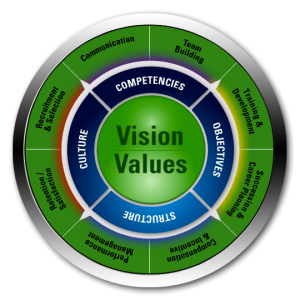What is The People First Model of Alignment?

At People First, we truly believe that an aligned workforce is a happy, engaged, and most importantly, successful one. We also recognize that corporate alignment does not always come easy, in fact, it rarely does. It isn’t necessarily a natural occurrence between an organization and its employees, but the good news is with planning, hard work, communication and customized facilitation, everything will fall into place and the results are undeniable.
What is Organizational Alignment?
We like to think of organizational alignment with a sports metaphor: a playbook for the entire company. In order for a team to win the big game, the coach has to make sure every player is on the same team, all striving for the same goal. So, the coaching staff creates a playbook that outlines the strategy and shares and discusses with every member of the team in real time.
When you watch a sporting event, it can feel like you are watching a carefully choreographed and purposeful strategy. Every player knows what is supposed to happen next. The same can, and should, occur within your organizational structure. It’s all about aligning with a playbook that puts you all on the same page.
The People First Model of Alignment
With the above in mind, we created the People First Model of Alignment, a way of getting your team on track and aligned with each other. With the Vision and Values of your organization in mind, we can take you through the concepts that comprise our model to align your team.
Competencies
Organizational competencies is likely not a term that is unfamiliar. It’s an idea that has been used in the world of performance management and personal development for years, referring to the wide breadth of employee skills that a company needs to reach their goals.
Our belief is that establishing your organizational competencies lies in team collaboration and communication. Teams that communicate well complete projects more efficiently and accurately than those who work in silos. They begin to naturally share information, knowledge and personal strengths, all while seeking to understand and build on the opinions of others to enhance their performance and outcomes.
Training should never end after orientation, competencies can always be expanded upon. It is needs to be an ongoing tool that your employees know they can rely on as a resource for professional and personal growth. Knowing that their employer wants to see them succeed and is putting them first results in a team that understands one another and wants to grow their roles together.
Objectives
Clearly communicated objectives and goals promote planning and productivity, but aligning your team to be goal oriented, with laser focus on your corporate objectives takes some work. Organizations need to utilize employee training and development to equip their team with the knowledge and skills that are reflective of the business’ strategic vision and objectives.
The best way to achieve organizational alignment in objective and goal setting is to make it a collaborative process. Aim to stay away from vague ideas and focus on SMART goals. Evaluate your goals against the following criteria — Are they Specific, Measurable, Attainable, Relevant and Timely? Once your employees are aligned with their (and your) goals, they will better align with their teams.
Structure
When it comes to organizational alignment, your corporate structure should reflect a people first mentality. It’s not just about the formal relationships, but the informal ones that keep a team happy, healthy and productive, giving your team physical alignment that results in clarity and efficiency.
Your organizational structure will always have a focus on the layout of departments and job roles in the context of reporting formal relationships, directly impacting performance management. Your team’s performance revolves around the relationships between supervisors and their subordinates, but with a people first mentality, always ensure there is guidance to help your people improve as you follow their struggles and successes.
Culture
At People First, we would argue that ultimately, culture fit is one of the most important, if not the most important aspect of recruiting and retaining great employees. Being able to define your organizational culture means creating a universal understanding of the values, beliefs, behaviours and experiences that comprise your organization’s environment.
The relationship between company culture and recruitment and retention are directly related with the brand image you project and maintain. Companies that take corporate culture seriously and actively market their culture to prospective employees and work hard to keep up that culture internally attract people who will thrive in your organization and make them want to stay once they’ve joined your mission.

